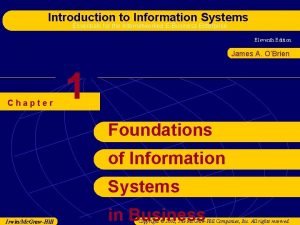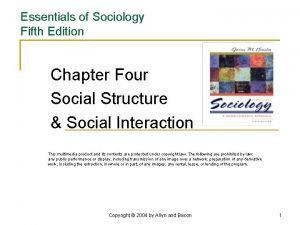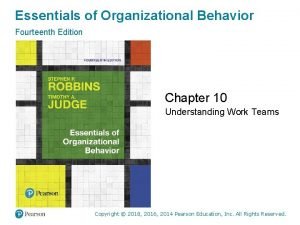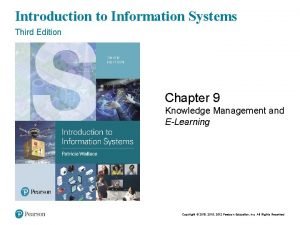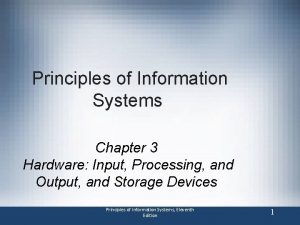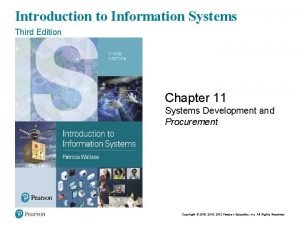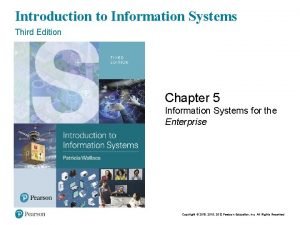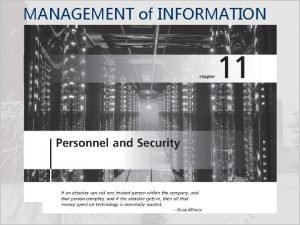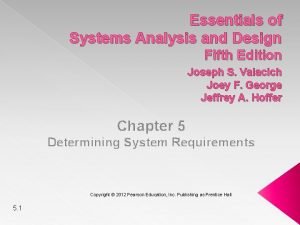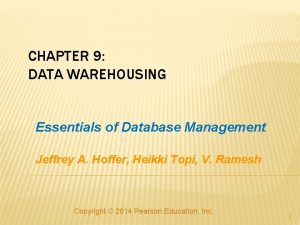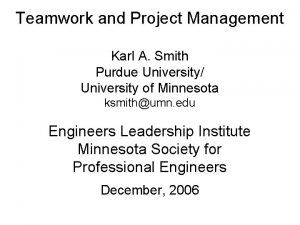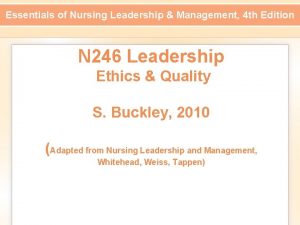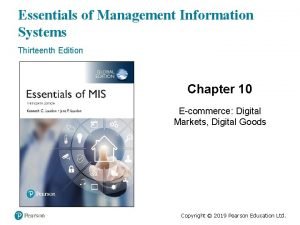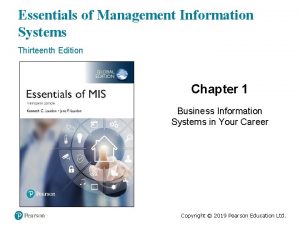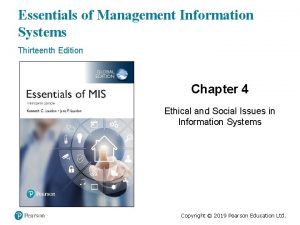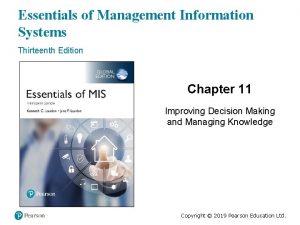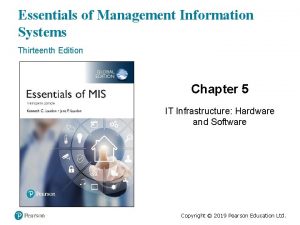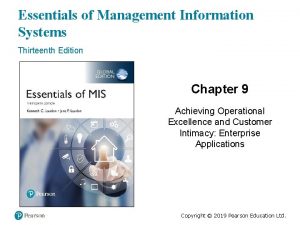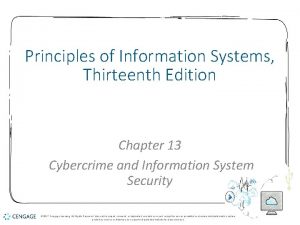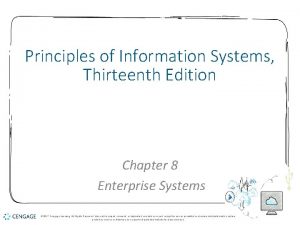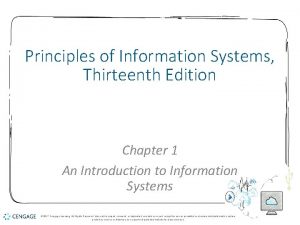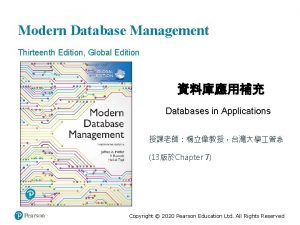Essentials of Management Information Systems Thirteenth Edition Chapter












































- Slides: 44

Essentials of Management Information Systems Thirteenth Edition Chapter 6 Foundations of Business Intelligence: Databases and Information Management Copyright © 2019 Pearson Education Ltd.

Learning Objectives 6. 1 What is a database, and how does a relational database organize data? 6. 2 What are the principles of a database management system? 6. 3 What are the principal tools and technologies for accessing information from databases to improve business performance and decision making? 6. 4 Why are information policy, data administration, and data quality assurance essential for managing the firm’s data resources? 6. 5 How will MIS help my career? Copyright © 2019 Pearson Education Ltd.

Video Cases • Case 1: Dubuque Uses Cloud Computing and Sensors to Build a Smarter City • Case 2: Brooks Brothers Closes in on Omnichannel Retail • Case 3: Maruti Suzuki Business Intelligence and Enterprise Databases Copyright © 2019 Pearson Education Ltd.

Data Management Helps the Charlotte Hornets Learn More About Their Fans • Problem – Large volumes of data in isolated databases – Outdated data management technology • Solutions – SAP HANA – Data warehouse – Fan. Tracker • Illustrates the importance of data management for better decision making and customer analysis Copyright © 2019 Pearson Education Ltd.

What is a Database? • Database: – Collection of related files containing records on people, places, or things • Entity: – Generalized category representing person, place, thing – E. g. , SUPPLIER, PART • Attributes: – Specific characteristics of each entity: ▪ SUPPLIER name, address ▪ PART description, unit price, supplier Copyright © 2019 Pearson Education Ltd.

Relational Databases • Organize data into two-dimensional tables (relations) with columns and rows • One table for each entity: – E. g. , (CUSTOMER, SUPPLIER, PART, SALES) – Fields (columns) store data representing an attribute – Rows store data for separate records, or tuples • Key field: uniquely identifies each record • Primary key Copyright © 2019 Pearson Education Ltd.

Figure 6. 2 A Relational Database Table Copyright © 2019 Pearson Education Ltd.

Figure 6. 3 The PART Table Copyright © 2019 Pearson Education Ltd.

Establishing Relationships (1 of 2) • Entity-relationship diagram – Used to clarify table relationships in a relational database • Relational database tables may have: – One-to-one relationship – One-to-many relationship – Many-to-many relationship ▪ Requires “join table” or intersection relation that links the two tables to join information Copyright © 2019 Pearson Education Ltd.

Figure 6. 4 A Simple Entity-Relationship Diagram Copyright © 2019 Pearson Education Ltd.

Establishing Relationships (2 of 2) • Normalization – Streamlining complex groups of data – Minimizes redundant data elements – Minimizes awkward many-to-many relationships – Increases stability and flexibility • Referential integrity rules – Ensure that relationships between coupled tables remain consistent Copyright © 2019 Pearson Education Ltd.

Figure 6. 5 Sample Order Report Copyright © 2019 Pearson Education Ltd.

Figure 6. 6 The Final Database Design with Sample Records Copyright © 2019 Pearson Education Ltd.

Figure 6. 7 Entity-Relationship Diagram for the Database with Four Tables Copyright © 2019 Pearson Education Ltd.

Database Management Systems (DBMS) • Software for creating, storing, organizing, and accessing data from a database • Separates the logical and physical views of the data – Logical view: how end users view data – Physical view: how data are actually structured and organized • Examples: Microsoft Access, DB 2, Oracle Database, Microsoft SQL Server, My. SQL Copyright © 2019 Pearson Education Ltd.

Figure 6. 8 Human Resources Database with Multiple Views Copyright © 2019 Pearson Education Ltd.

Operations of a Relational DBMS • Select: – Creates a subset of all records meeting stated criteria • Join: – Combines relational tables to present the server with more information than is available from individual tables • Project: – Creates a subset consisting of columns in a table – Permits user to create new tables containing only desired information Copyright © 2019 Pearson Education Ltd.

Figure 6. 9 The Three Basic Operations of a Relational DBMS Copyright © 2019 Pearson Education Ltd.

Capabilities of Database Management Systems • Data definition capabilities: – Specify structure of content of database • Data dictionary: – Automated or manual file storing definitions of data elements and their characteristics • Querying and reporting: – Data manipulation language ▪ Structured query language (SQL) ▪ Microsoft Access query-building tools – Report generation, e. g. , Crystal Reports Copyright © 2019 Pearson Education Ltd.

Figure 6. 10 Access Data Dictionary Features Copyright © 2019 Pearson Education Ltd.

Figure 6. 11 Example of an SQL Query SELECT PART. Part_Number, PART. Part_Name, SUPPLIER. Supplier_Number, SUPPLIER. Supplier_Name FROM PART, SUPPLIER WHERE PART. Suplier_Number = SUPPLIER. Supplier_Number AND Part_Number = 137 OR Part_Number = 150; Copyright © 2019 Pearson Education Ltd.

Figure 6. 12 An Access Query Copyright © 2019 Pearson Education Ltd.

Non-Relational Databases • “No. SQL” • Handle large data sets of data that are not easily organized into tables, columns, and rows • Use more flexible data model – Don’t require extensive structuring • Can manage unstructured data, such as social media and graphics • E. g. Amazon’s Simple. DB, Met. Life’s Mongo. DB Copyright © 2019 Pearson Education Ltd.

Cloud Databases and Distributed Databases • Relational database engines provided by cloud computing services – Pricing based on usage – Appeal to small or medium-sized businesses • Amazon Relational Database Service – Offers My. SQL, Microsoft SQL Server, Oracle Database engines • Distributed databases – Stored in multiple physical locations – Google’s Spanner cloud service Copyright © 2019 Pearson Education Ltd.

The Challenge of Big Data • Massive quantities of unstructured and semi-structured data from Internet and more – 3 Vs: Volume, variety, velocity – Petabytes and exabytes • Big datasets offer more patterns and insights than smaller datasets, e. g. – Customer behavior – Weather patterns • Requires new technologies and tools Copyright © 2019 Pearson Education Ltd.

Business Intelligence Infrastructure • Array of tools for obtaining useful information from internal and external systems and big data – Data warehouses – Data marts – Hadoop – In-memory computing – Analytical platforms Copyright © 2019 Pearson Education Ltd.

Data Warehouses • Data warehouse: – Database that stores current and historical data that may be of interest to decision makers – Consolidates and standardizes data from many systems, operational and transactional databases – Data can be accessed but not altered • Data mart: – Subset of data warehouses that is highly focused and isolated for a specific population of users Copyright © 2019 Pearson Education Ltd.

Hadoop • Open-source software framework for big data • Breaks data task into sub-problems and distributes the processing to many inexpensive computer processing nodes • Combines result into smaller data set that is easier to analyze • Key services – Hadoop Distributed File System (HDFS) – Map. Reduce Copyright © 2019 Pearson Education Ltd.

In-Memory Computing • Relies on computer’s main memory (RAM) for data storage • Eliminates bottlenecks in retrieving and reading data • Dramatically shortens query response times • Enabled by high-speed processors, multicore processing • Lowers processing costs Copyright © 2019 Pearson Education Ltd.

Analytic Platforms • Preconfigured hardware-software systems • Designed for query processing and analytics • Use both relational and non-relational technology to analyze large data sets • Include in-memory systems, No. SQL DBMS • E. g. IBM Pure. Data System for Analytics – Integrated database, server, storage components • Data lakes Copyright © 2019 Pearson Education Ltd.

Figure 6. 13 Business Intelligence Technology Infrastructure Copyright © 2019 Pearson Education Ltd.

Interactive Session – Society: Societe Generale Builds an Intelligent System to Manage Information Flow • Class discussion – Why did Societe Generale’s managers decide to develop an automated transaction processing system? – Why did managers decide they needed an “intelligent system? ” In what way was the new system “intelligent? ” – What is the role of human decision makers in the new system? – Why did managers select the Infogix platform? Copyright © 2019 Pearson Education Ltd.

Analytical Tools: Relationships, Patterns, Trends • Once data is gathered, tools are required for consolidating, analyzing, to use insights to improve decision making – Software for database querying and reporting – Multidimensional data analysis (OLAP) – Data mining Copyright © 2019 Pearson Education Ltd.

Online Analytical Processing (OLAP) • Supports multidimensional data analysis, enabling users to view the same data in different ways using multiple dimensions – Each aspect of information—product, pricing, cost, region, or time period—represents a different dimension – E. g. , comparing sales in East in June versus May and July • Enables users to obtain online answers to ad hoc questions such as these in a fairly rapid amount of time Copyright © 2019 Pearson Education Ltd.

Figure 6. 14 Multidimensional Data Model Copyright © 2019 Pearson Education Ltd.

Data Mining • Finds hidden patterns and relationships in large databases and infers rules from them to predict future behavior • Types of information obtainable from data mining – Associations: occurrences linked to single event – Sequences: events linked over time – Classifications: patterns describing a group an item belongs to – Clustering: discovering as yet unclassified groupings – Forecasting: uses series of values to forecast future values Copyright © 2019 Pearson Education Ltd.

Text Mining • Unstructured data (mostly text files) accounts for 80 percent of an organization’s useful information. • Text mining allows businesses to extract key elements from, discover patterns in, and summarize large unstructured data sets. • Sentiment analysis – Mines online text comments online or in email to measure customer sentiment Copyright © 2019 Pearson Education Ltd.

Web Mining • Discovery and analysis of useful patterns and information from the web – E. g. to understand customer behavior, evaluate website, quantify success of marketing • Content mining – mines content of websites • Structure mining – mines website structural elements, such as links • Usage mining – mines user interaction data gathered by web servers Copyright © 2019 Pearson Education Ltd.

Databases and the Web • Firms use the web to make information from their internal databases available to customers and partners. • Middleware and other software make this possible – Web server – Application servers or CGI – Database server • Web interfaces provide familiarity to users and savings over redesigning legacy systems. Copyright © 2019 Pearson Education Ltd.

Figure 6. 15 Linking Internal Databases to the Web Copyright © 2019 Pearson Education Ltd.

Establishing an Information Policy • Information policy – States organization’s rules for organizing, managing, storing, sharing information • Data administration – Responsible for specific policies and procedures through which data can be managed as a resource • Database administration – Database design and management group responsible for defining and organizing the structure and content of the database, and maintaining the database. Copyright © 2019 Pearson Education Ltd.

Ensuring Data Quality • Poor data quality: major obstacle to successful customer relationship management • Data quality problems caused by: – Redundant and inconsistent data produced by multiple systems – Data input errors • Data quality audit • Data cleansing Copyright © 2019 Pearson Education Ltd.

Interactive Session – Organizations: Data-Driven Policing Goes Global • Class discussion – What are the benefits of intelligence-driven prosecution for crime fighters and the general public? – What problems does this approach to crime fighting pose? – What management, organization, and technology issues should be considered when setting up information systems for intelligence-driven prosecution? Copyright © 2019 Pearson Education Ltd.

How Will MIS Help My Career? • The Business: Mega Midwest Power • Position Description • Job Requirements • Interview Questions Copyright © 2019 Pearson Education Ltd.
 Voyage estimating decision support system
Voyage estimating decision support system Vertical
Vertical Introduction to information systems 5th edition
Introduction to information systems 5th edition Business essentials 12th edition chapter 1
Business essentials 12th edition chapter 1 Essentials of information systems
Essentials of information systems William stallings network security essentials 5th edition
William stallings network security essentials 5th edition Essentials of investments 11th edition
Essentials of investments 11th edition Business essentials 12th edition free
Business essentials 12th edition free Essentials of sociology 5th edition
Essentials of sociology 5th edition Firefighter essentials 7th edition
Firefighter essentials 7th edition Business essentials 12th edition
Business essentials 12th edition Essentials of organizational behavior 14th edition
Essentials of organizational behavior 14th edition At a bulk transport incident firefighters must
At a bulk transport incident firefighters must Network security essentials 5th edition
Network security essentials 5th edition Criminal justice the essentials 5th edition
Criminal justice the essentials 5th edition Introduction to information systems 6th edition
Introduction to information systems 6th edition Fundamentals of information systems 9th edition
Fundamentals of information systems 9th edition Fundamentals of information systems 9th edition
Fundamentals of information systems 9th edition Principles of information systems
Principles of information systems Introduction to information systems 3rd edition
Introduction to information systems 3rd edition Principles of information system
Principles of information system Principles of information systems 11th edition
Principles of information systems 11th edition Fundamentals of information systems 9th edition
Fundamentals of information systems 9th edition Introduction to information systems 3rd edition
Introduction to information systems 3rd edition Fundamentals of information systems 9th edition
Fundamentals of information systems 9th edition Introduction to information systems 3rd edition
Introduction to information systems 3rd edition Management information system chapter 1
Management information system chapter 1 Introduction management information system
Introduction management information system What is goal congruence in management control system
What is goal congruence in management control system Information technology project management 9th edition
Information technology project management 9th edition Blue project chapter 5
Blue project chapter 5 Management of information security 5th edition
Management of information security 5th edition Project management quality control
Project management quality control Information technology project management 9th edition
Information technology project management 9th edition Information technology project management 9th edition
Information technology project management 9th edition Essentials of systems analysis and design
Essentials of systems analysis and design Mis chapter 6
Mis chapter 6 Using mis (10th edition) 10th edition
Using mis (10th edition) 10th edition Principles of management (collection) stephen p. robbins
Principles of management (collection) stephen p. robbins Essentials of migration management
Essentials of migration management Essentials of database management
Essentials of database management Purdue project management essentials
Purdue project management essentials Essentials of migration management
Essentials of migration management Essentials of nursing leadership & management
Essentials of nursing leadership & management Essentials of migration management
Essentials of migration management




